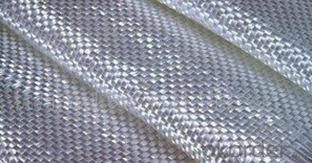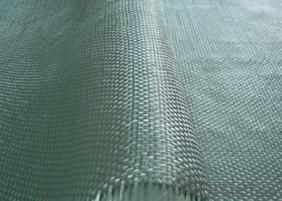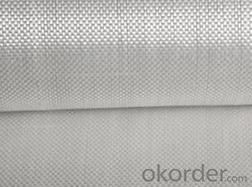E-glass Fiberglass Woven Roving,800g,1200mm
- Loading Port:
- Shanghai
- Payment Terms:
- TT or LC
- Min Order Qty:
- 3000 kg
- Supply Capability:
- 50000 kg/month
OKorder Service Pledge
OKorder Financial Service
You Might Also Like
Structure of woven roving Description
Woven roving is made of direct rovings in Plain,Twill weave pattern.The input rovings are designed to give controlled wet-out and excellent laminate properties. It is compatible with Polyester,Vinyl ester and Epoxy resin and widely used in hand machine production, such as boats,vessels,plane and automotive parts,furniture,sports and other areas.
Main Features of the woven roving
Consistet thickness and excellent surface treatment;
Rapid impregnating and good compatibility with resin;
Uniform tension, high dimensional stability and easy operation;
Good mechanical properties and high strength of parts
Woven roving Images



Woven roving Specification:
Normal type | EWR800 | EWR400 | EWR300 | EWR500 | EWR600 |
Thickness (mm) | 0.8 | 0.4 | 0.3 | 0.5 | 0.6 |
Density(warpxweft) (end/cm) | 1.8x1.5+/-10% | 3.6x3.2+/-10% | 4.6x4.1+/-10% | 2.2X2.0+/-10% | 2.6X2.4+/-10% |
Tex (warpxweft) | 2400x2400 | 600X600 | 300x400 | 1200x1200 | 1200X1200 |
Moisture content(%) | <0.2% | <0.2% | <0.2% | <0.2% | <0.2% |
Loss on ignition(%) | 0.4 – 0.8 | 0.4-0.8 | 0.4-0.8 | 0.4-08 | 0.4-0.8 |
Width(cm) | 125+/-1 | 125+/-1 | 125+/-1 | 125+/-1 | 125+/-1 |
Weight (g/m2) | 816+/-41 | 408+/-32 | 300+/-15 | 500+/-25 | 600+/-30 |
Weight per roll(kg) | 45 | 46 | 50 | 45 | 45 |
Glass | E-glass | E-glass | E-glass | E-glass | E-glass |
FAQ of woven roving:
1.Q: What specification do you have for e-glass woven roving ?
A: Now our normal specification have 400/450/500/600/800g/m2, But 200 - 1600g/m2 are available.
2.Q:How about the width?
A:The normal width is 1040mm and 1270mm, can be from 50mm to 3000mm.
3.Q:How about the sample delivery?
A.Small sample is free of charge, sample ready time 3-5days.
4.Q:How about the delivery time?
A:It is depend on the order quantity, three 20'ft container around 20days.
Application of Fiberglass Woven Roving:
a) boats ,vessels ,plane
b) automotive parts ,furniture and sports facilities
c) resins system,such as polyeser,vinylester and epoxy resins
- Q:Can fiberglass mat tissue be used for thermal insulation?
- No, fiberglass mat tissue is not typically used for thermal insulation. It is primarily used for reinforcing and providing strength to composite materials such as fiberglass sheets or panels. For thermal insulation purposes, other materials such as mineral wool, foam, or cellulose insulation are commonly used.
- Q:How does the density of fiberglass mat tissue impact its performance?
- The density of fiberglass mat tissue directly affects its performance. Higher density mat tissue is typically stronger and more durable, providing better structural support and resistance to impact. On the other hand, lower density mat tissue is lighter and more flexible, making it suitable for applications where weight and flexibility are important factors. Ultimately, the density of fiberglass mat tissue plays a crucial role in determining its strength, flexibility, and overall performance.
- Q:How does the fiber distribution of fiberglass mat tissue affect its strength?
- The strength of fiberglass mat tissue is significantly influenced by the distribution of its fibers. The primary source of strength for fiberglass mat tissue is the inclusion of fibers within the material. These fibers act as reinforcement and aid in evenly distributing stress and load across the surface. The distribution of fibers in fiberglass mat tissue refers to their arrangement and orientation within the material. When fibers are evenly distributed, with a consistent arrangement and orientation, the strength of the fiberglass mat tissue is enhanced. This uniform distribution allows for efficient transfer of load from one fiber to another, resulting in improved overall strength. Conversely, an uneven or random distribution of fibers, where they are clumped together or oriented in various directions, compromises the strength of the fiberglass mat tissue. This uneven distribution can create areas of concentrated stress, leading to weak points and potential failure under load. Additionally, the strength of fiberglass mat tissue is also influenced by the length and density of the fibers. Longer fibers provide greater reinforcement and enhance the tensile strength of the material. Furthermore, a higher fiber density, meaning more fibers per unit area, increases the overall strength and performance of the fiberglass mat tissue. In conclusion, the strength of fiberglass mat tissue is directly impacted by the distribution of its fibers. A uniform and evenly distributed arrangement of fibers improves the material's strength by facilitating efficient load transfer. Conversely, an uneven or random distribution compromises the strength by creating stress concentrations and weak points. The fiber length and density also contribute to the overall strength of the fiberglass mat tissue.
- Q:Is fiberglass mat tissue easy to install?
- Yes, fiberglass mat tissue is relatively easy to install. It is lightweight and flexible, making it convenient to handle and work with. Additionally, it can be easily cut to the desired size and shape, allowing for precise installation in various applications.
- Q:How does fiberglass mat tissue perform in terms of moisture vapor resistance?
- Fiberglass mat tissue generally performs well in terms of moisture vapor resistance. The material itself is not permeable to moisture, meaning it acts as a barrier to prevent the passage of water vapor. This characteristic makes fiberglass mat tissue suitable for applications where moisture control is important, such as in roofing or insulation. The moisture vapor resistance of fiberglass mat tissue can be further enhanced by using it in conjunction with other materials, such as vapor barriers or moisture-resistant coatings. These additional layers can provide an extra level of protection against moisture infiltration, improving the overall performance of the fiberglass mat tissue in terms of moisture vapor resistance. However, it is important to note that the specific moisture vapor resistance of fiberglass mat tissue can vary depending on its thickness, density, and composition. Thicker and denser fiberglass mats generally offer higher moisture vapor resistance compared to thinner and less dense ones. Additionally, the presence of any manufacturing additives or coatings can also affect the material's moisture vapor resistance properties. In summary, fiberglass mat tissue is known for its good moisture vapor resistance capabilities, but its exact performance in this regard can be influenced by various factors. It is advisable to consult product specifications or manufacturers' recommendations to determine the specific moisture vapor resistance of a particular fiberglass mat tissue product.
- Q:What is the expected lifespan of fiberglass mat tissue?
- The lifespan of fiberglass mat tissue can differ based on several factors, including material quality, exposure conditions, and specific usage. Nonetheless, fiberglass mat tissue is renowned for its longevity and durability. When manufactured and installed correctly, fiberglass mat tissue has the potential to endure for many decades. It possesses resistance against decay, corrosion, and various chemicals, making it suitable for diverse industries and applications. Furthermore, fiberglass mat tissue is esteemed for its strength and capacity to withstand high temperatures. Nevertheless, it is crucial to acknowledge that prolonged exposure to harsh environmental elements, such as extreme temperatures, UV radiation, and moisture, may gradually degrade the material. Regular maintenance and appropriate care can aid in prolonging the lifespan of fiberglass mat tissue. In conclusion, while it remains challenging to determine an exact anticipated lifespan for fiberglass mat tissue, it is generally perceived as a long-lasting material when utilized and maintained properly.
- Q:Does fiberglass mat tissue provide any thermal insulation?
- Indeed, thermal insulation is provided by fiberglass mat tissue. The reason lies in the fact that fiberglass possesses a low heat conductivity, impeding the effortless transfer of heat. As a mat tissue, it successfully captures air within its fibers, thereby generating an insulation layer. This layer serves as a shield against heat transfer via conduction and diminishes the loss of thermal energy. Consequently, fiberglass mat tissue proves to be a viable remedy for achieving thermal insulation in numerous sectors, including construction, automotive, and aerospace industries.
- Q:What is the thickness range of fiberglass mat tissue?
- The thickness range of fiberglass mat tissue typically varies between 0.2mm to 3mm.
- Q:Can fiberglass mat tissue be used for composite tooling?
- Yes, fiberglass mat tissue can be used for composite tooling. It is commonly used as a reinforcement material in composite tooling due to its high strength, durability, and ease of use. It helps to provide structural support and stability to the tooling, making it suitable for various applications in the composite industry.
- Q:Is fiberglass mat tissue suitable for automotive panel repairs?
- Yes, fiberglass mat tissue is suitable for automotive panel repairs. Fiberglass mat tissue is a versatile and durable material that is commonly used in automotive repairs. It is particularly effective for repairing and reinforcing damaged or weakened areas on automotive panels. Fiberglass mat tissue provides a strong and stable foundation for repairing dents, cracks, or holes in panels, and it can be easily shaped and molded to fit the contours of the panel. Additionally, fiberglass mat tissue is resistant to rust and corrosion, making it a reliable choice for automotive repairs that need to withstand harsh weather conditions and road debris. Overall, fiberglass mat tissue is a suitable and widely-used material for automotive panel repairs due to its strength, durability, and versatility.
1. Manufacturer Overview |
|
|---|---|
| Location | |
| Year Established | |
| Annual Output Value | |
| Main Markets | |
| Company Certifications | |
2. Manufacturer Certificates |
|
|---|---|
| a) Certification Name | |
| Range | |
| Reference | |
| Validity Period | |
3. Manufacturer Capability |
|
|---|---|
| a)Trade Capacity | |
| Nearest Port | |
| Export Percentage | |
| No.of Employees in Trade Department | |
| Language Spoken: | |
| b)Factory Information | |
| Factory Size: | |
| No. of Production Lines | |
| Contract Manufacturing | |
| Product Price Range | |
Send your message to us
E-glass Fiberglass Woven Roving,800g,1200mm
- Loading Port:
- Shanghai
- Payment Terms:
- TT or LC
- Min Order Qty:
- 3000 kg
- Supply Capability:
- 50000 kg/month
OKorder Service Pledge
OKorder Financial Service
Similar products
New products
Hot products
Related keywords





























